What Percent of Families Does the Wife Stay Home
Devotees of reality TV may retrieve that stay-at-dwelling house moms are more common among the rich—think the " Real Housewives" of Orangish County, of Beverly Hills, of Atlanta, and so on. By contrast, close observers of American family unit life may think stay-calm moms are more common among the poor.
It turns out they are both right, according to a new Plant for Family Studies analysis of the 2022 American Customs Survey. Among mothers married to husbands who work full-time and year-round—the population well-nigh likely to have the option of staying home—there is a U-shaped bend between a mother's chances of existence out of the labor force and her husband's earned income. That is, the real housewives of America are well-nigh probable to be constitute among women married to men earning merely a little orquite a lot.
Shut to half of mothers whose husbands earn $250,000 or higher a year (46%) are not in the labor strength. On the other terminate of the income spectrum, 35% of mothers whose husbands make less than $25,000 a year are stay-at-domicile moms. Mothers married to husbands with an income between $fifty,000 and $75,000—the group that includes the median husband'south income of $60,000—are the least likely to stay at dwelling house; only 25% of them are out of the labor forcefulness.
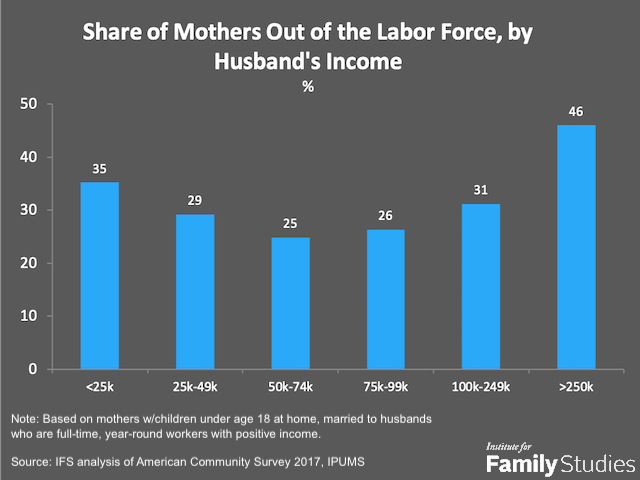
We're not showing up at the "mommy wars" to support a sure side—VerBruggen is the son of a stay-calm mom and the husband of a working 1, and so he'due south not allowed to say anything judgmental about either organization, while Wang is a working mom who is sometimes envious of her stay-at-domicile friends. But when we noticed this blueprint, we couldn't resist exploring these data farther, both to sort out the human relationship between husbands' income and wives' working decisions and to see if it has inverse in contempo years, especially because breadwinner moms take become more common in today'southward families.
So why would nosotros see a U shape rather than a linear relationship between men's income and women's labor force participation? After all, economical theory might predict a simple rising line, considering equally 1'southward spouse makes more coin, the returns to additional income diminish and thus staying at dwelling house becomes more attractive to at to the lowest degree some women.
A couple of factors are at play. First of all, people with similar educational and economic backgrounds tend to marry each other—a phenomenon known as "assortative mating." Lower-income men oft partner with women whose potential earned income is also lower. When children are in the flick, the loftier childcare costs oft outweigh that (potential) second income. For these couples, it oft makes more financial sense, given high childcare costs and her low potential earnings, to have someone stay at domicile, usually mom.
Merely on the other paw, higher-income men tend to marry women with higher education and higher earnings. For these mothers, opting out of the workforce carries a higher opportunity price. Therefore, just when the hubby'south income reaches a certain level, can the family unit start to "afford" to have these women stay at home.
Of grade, we are only talking nearly raising children in economic terms hither. Despite parenting being time-consuming and exhausting work, parents actually find the time they spend taking care of their children more rewarding than the time they spend at work, according to Wang's earlier research using time-employ data. Moreover, in an age of helicopter parenting, raising children ofttimes feels like more than than a total-time job today. It is no surprise that some women may want to or experience similar they need to trade their professional jobs for a full-time (unpaid) task at home.
I way of testing this is to look at the impact of education on the married mothers in our sample because education is a rough proxy for earning chapters. And what makes this complicated is that information technology really is the instance that higher-earning dads take college-educated wives. The higher the father's income, the more probable it is that the mother has a BA or more—above 75% when the father'due south income tops $250,000. Then, the pedagogy dynamic may straighten out the curve somewhat for more than educated women.
We wouldn't expect to fullystraighten out the curve past bookkeeping for this, because assortative mating happens within educational categories as well. (For instance, Ivy League grads are disproportionately likely to marry other Ivy League grads, not simply to marry higher grads in general.) Just we should expect the left-mitt side of the shape to be less pronounced when women are separated by education.
Indeed, that is what we run across. A 10-point drib in labor-force opting-out amongst married mothers in our initial chart is cut down by half or more within educational categories.1
This theory, then, is a good fit for the data and makes a great deal of intuitive sense. Further, our results are strikingly similar when the aforementioned analyses are run on the 2010 ACS instead of the 2022 ACS, suggesting that these patterns are reasonably stable over the short run. It appears there has been little change in the relationship between men's income and women's moves to stay at abode amongst married parents over the course of the last seven years.
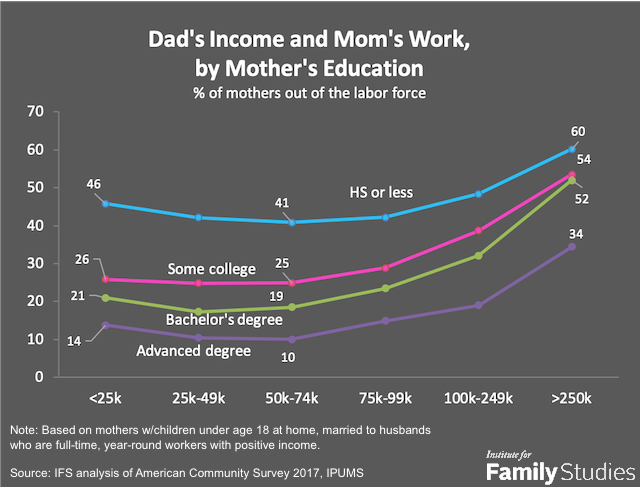
To be certain, there is a departure between a utilitarian theory consequent with the facts and an ironclad causal inference. There are other ways to interpret these findings, some of which are probably another part of the story and deserve farther exploration. There may be a selection effect in which higher-earning men seek out women willing to stay home, for example, or differences in values among women of different skill levels. In previous work, Wang establish that lower-income women are more likely to say their ideal system would be to work full fourth dimension.
Farther, while didactics is a proxy for earning capacity, it's likewisean indication of a adult female's intention to work; a college educational activity is, afterward all, largely an investment in 1'southward future power to make money.
And as it happens, a new survey conducted by IFS and the Wheatley Institution sheds even more lite on the factors related to women's labor-forcefulness participation.
The "Ideal" Work Situation for Mothers
Having children is a major life-irresolute event for both men and women. And priorities in life tin can as well change considering of parenthood. When asked what their platonic work situation would be, only 28% of American married mothers say information technology is full-time work, whereas 43% of married women without children say so, according to our new survey.2
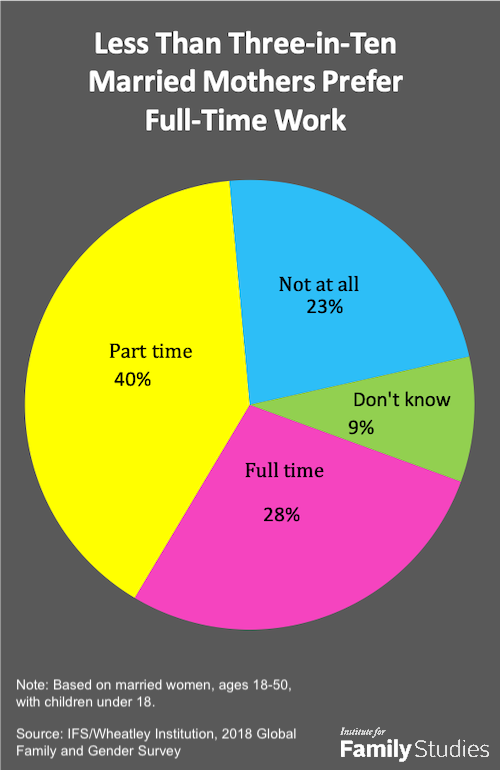
Meanwhile, 40% of married mothers consider working office-time to be their ideal situation, which makes function-fourth dimension piece of work the most popular option. And more than one-in-five married mothers adopt not to work for pay at all. (The rest, ix% of married mothers, haven't fabricated up their mind yet.)
Children's historic period also plays a role in mothers' preferences. Amidst married mothers with children ages 0 to 3 at home, merely 17% prefer to work total time, and 34% consider staying at home as their ideal situation. In contrast, 31% of married mothers with children ages 4 to 17 prefer total-fourth dimension piece of work, and 21% prefer non to work outside the home. The share of married mothers who prefer role-time piece of work is around xl%, regardless of their children's historic period.
Overall, mothers are more likely than non-mothers to express a stronger desire to either piece of work part time or non at all, regardless of their marital condition. Findings from the new IFS/Wheatley Institution survey suggest that 37% of mothers with children under age 18 prefer office-time work, and 21% prefer not to work exterior the home at all (32% prefer full-time work). And amongst women without children under age xviii, merely 28% adopt to work role time, 10% prefer not to work, and 51% consider full-time work their platonic.
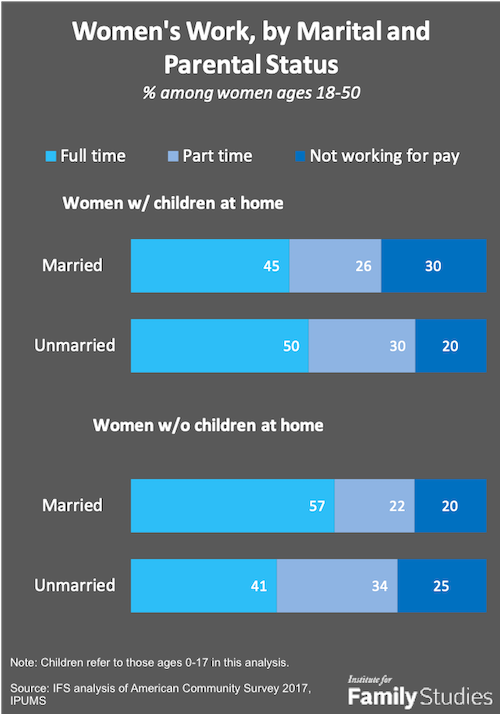
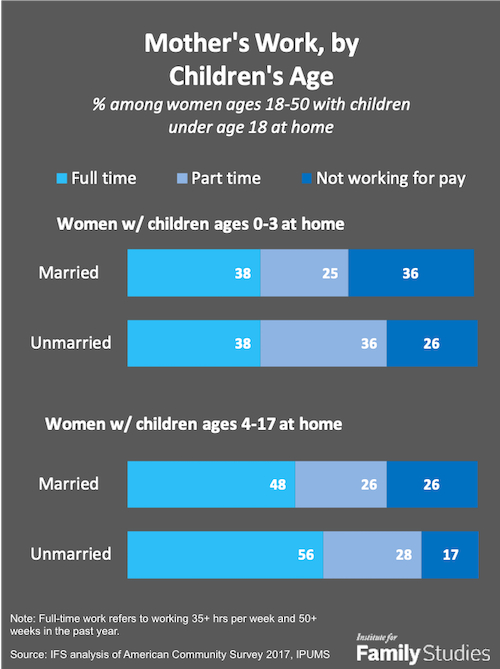
Given that the survey was conducted online and allowed respondents to report "don't know" in their responses, the results are not directly comparable to those of previous telephone-based surveys on the same topic. Nevertheless, they are broadly consistent with what previous surveys found. For case, in a 2012 Pew Enquiry Heart telephone-based survey, 53% of married mothers said that part-time piece of work was ideal and 23% preferred not working for pay at all.
Information technology is of import to note that the "ideal" situation does non always marshal with reality. Despite a strong preference for function-time work, only 26% of married mothers ages 18-fifty piece of work part-fourth dimension, according to our analyses of the 2022 American Customs Survey. In dissimilarity, 45% of married mothers work full-time, and xxx% do not work for pay.
Marriage just past itself today does not seem to have an impact on women's labor-force participation. In fact, amid women without children under age 18 at domicile, married women are more likely than unmarried women to work full-time. This could be considering highly-educated women today are more than likely than their less-educated peers to ally, and also more likely to work total fourth dimension.
Even so, parenthood nevertheless matters. Married mothers are more than likely to be out of the labor strength than other women. For women ages 18-50, the group virtually likely to not be working is married mothers (30%).
On the other hand, a mother's work status differs sharply by her children's ages. Only 38% of mothers with infants and toddlers work full fourth dimension, regardless of their marital condition. And 36% of married mothers with children ages 0 to 3 practise not work outside the dwelling. The share among unmarried mothers with children at this age is somewhat lower (26%).
Mothers are much more probable to piece of work full-time when their children are older. Close to half of married mothers with children ages 4 to 17 at dwelling (48%) work full time, and a majority of single mothers with children of like ages work full time (56%).
It is not surprising to see that mothers of children ages 0 to 3 are the group who are most likely to stay at dwelling. Children at this age demand an enormous amount of parental intendance, and it is very expensive to outsource this job. The almanac kid-intendance price for a young kid now exceeds $12,000, on par with college tuition, in many states in America. Given current costs, for many parents (not merely mothers), staying at dwelling house makes more economical sense.
In the terminate, what nosotros meet in the information is that different families split up piece of work and family unit responsibilities in different ways—sometimes because of how much money a spouse is bringing in, sometimes because of the cost of child intendance, and sometimes simply because different people value different things. Only what this research cursory tells us is that her education, his income, and their child's historic period all loom large in shaping who does what in contemporary American married families.
Robert VerBruggen is a Research Fellow of the Constitute for Family Studies and deputy managing editor of National Review. Wendy Wang, Ph.D., is Managing director of Research of the Found for Family unit Studies and the atomic number 82 author of Breadwinner Moms(Washington, DC: Pew, 2013). Download a re-create of this inquiry brief here.
i. A logistic regression predicting the labor-force participation of the wives in our sample is consistent with this story also. When the women's race, nativity, and historic period are controlled, along with a dummy variable indicating whether any children are under age 5, paternal incomes are positively correlated with beingness out of the labor force, while higher levels of maternal pedagogy are negatively correlated.
ii. The survey was conducted on Sep 13-25, 2018, with a nationally representative sample of ii,025 adults ages 18-l in the U.S. via the Knowledge Panel of Ipsos. Information technology is part of the IFS/Wheatley Institution 2022 Global Family unit & Gender Survey (GFGS).
Source: https://ifstudies.org/blog/the-real-housewives-of-america-dads-income-and-moms-work
0 Response to "What Percent of Families Does the Wife Stay Home"
Post a Comment